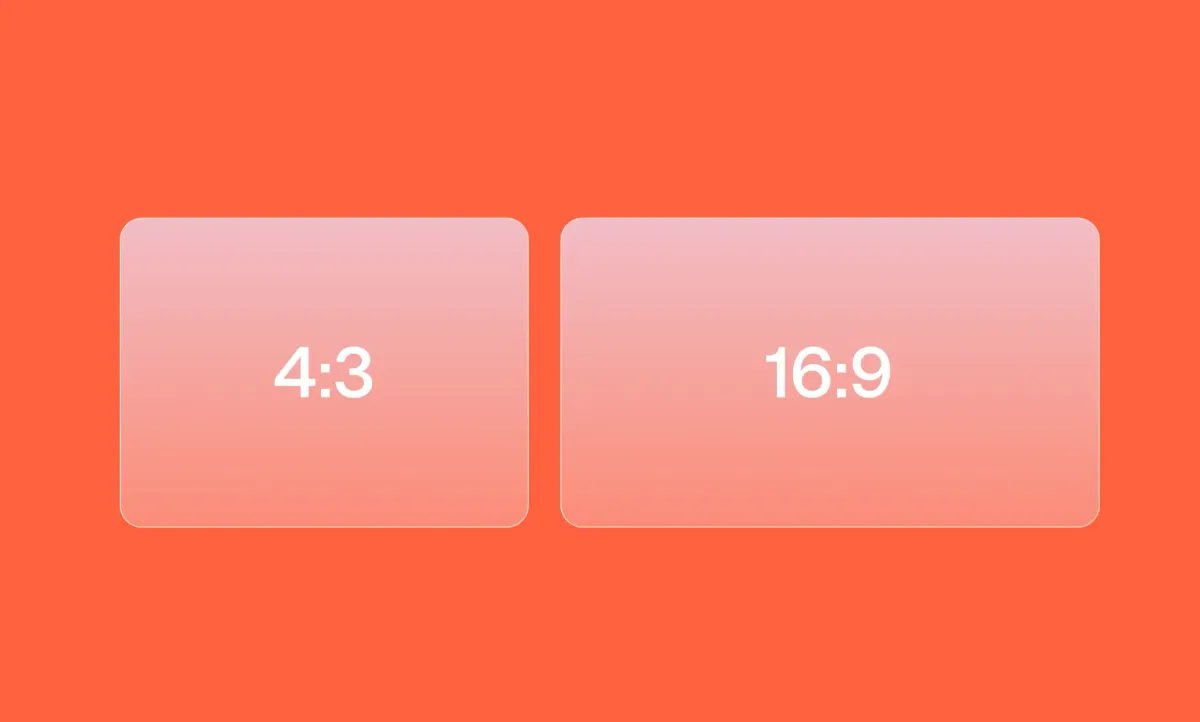When you're creating content, the visual side of things can make or break your project. And while we obsess over lighting, camera angles, and editing tricks, there's one underdog element that quietly shapes how people experience your work: aspect ratio.
If you've ever wondered whether to go with the classic 4:3 or stick with the widescreen 16:9 (or maybe you're not even sure what those numbers mean), you're in the right place.
Maybe you're putting together YouTube videos, turning your podcast into something people can actually watch, or just trying to figure out what works best on social media, this choice matters more than you might think.
So let's dig into the whole 4:3 versus 16:9 thing and figure out what actually works in 2025.
TL;DR
- Aspect ratio = frame shape: 4:3 is more square and nostalgic; 16:9 is widescreen and modern. Your aspect ratio affects how your content feels and fits on different platforms.
- 16:9 is the current standard: It’s ideal for YouTube, TVs, and most digital screens. It supports HD/4K resolutions and delivers a cinematic, immersive viewing experience.
- 4:3 is a creative choice: While not mainstream, it offers tighter framing and vintage vibes: perfect for intimate, artsy, or retro-inspired projects.
- Platform dictates format: Choose your aspect ratio based on where your content will live. YouTube prefers 16:9, Instagram Reels and TikTok love 9:16, and square/4:5 works well in feeds. 4:3 can add a nostalgic or documentary-style feel, especially for YouTube vlogs or creative edits.
- Resizing made easy with Podcastle: Even if you shoot in the “wrong” format, Podcastle’s editor lets you reframe, resize, and export your video in the ideal ratio for any platform, no reshooting required.
What is Aspect Ratio?
Aspect ratio is simply the relationship between the width and height of a video or image frame. Represented as two numbers separated by a colon (for example, 4:3 or 16:9), it tells you how wide a frame is compared to its height.
What is 4:3?
The 4:3 aspect ratio means the frame is 4 units wide and 3 units tall. It’s more square than widescreen, and you’ve probably seen it in older TV shows, early movies, or footage from older camcorders.
This format gives you a closer, more intimate frame. It works well when you want the focus tight on your subject. It also has a nostalgic feel, which is why some filmmakers and creators still use it today. It instantly gives your video a vintage look.
What is 16:9?
The 16:9 ratio is what you see on most screens today. It’s wider than 4:3 and gives you more room in the frame, which helps when you’re filming landscapes, group shots, or anything that needs space to breathe.
Most phones, cameras, and platforms like YouTube and Netflix default to 16:9. It’s the safest choice if you want your content to fit naturally across devices without cropping or black bars.
4:3 vs 16:9 Aspect Ratio Overview
Let’s have a look at a detailed side-by-side breakdown of these two formats so you can decide which works best for your content.
Aspect Ratio and Field of View
We’ll start with the shape itself. As we’ve already established, aspect ratio determines how your video is framed and how much of the scene your audience can see.
4:3
- Nearly square frame
- Narrower field of view - ideal for close-ups or centered subjects
- Often creates a nostalgic or intimate look
- Great for tight compositions like dialogues or portraits
16:9
- Wide rectangular frame
- Expansive field of view - perfect for landscapes, interviews, and cinematic storytelling
- Feels more modern and immersive
- Ideal for scenes with multiple subjects or dynamic movement
Resolution and Size
Resolution matters when you're thinking about clarity and platform compatibility. The aspect ratio directly influences what resolutions you can use and how sharp your video appears.
Common 4:3 Resolutions
- 640×480 (VGA)
- 800×600 (SVGA)
- 1024×768 (XGA)
- 1152×864 (XGA+)
Common 16:9 Resolutions
- 16:9: 1280×720 (HD)
- 1920×1080 (Full HD)
- 3840×2160 (4K)
- 2560×1440 (QHD)
- 3840×2160 (4K UHD)
- 7680×4320 (8K UHD)
Key Resolution Differences
- 4:3 limits your resolution options, making it less ideal for high-definition platforms.
- 16:9 is designed for today’s display technology: HDTVs, smartphones, and computer monitors all default to this shape.
- Higher resolution means more detail, but also larger files and higher production demands.
Bitrate and File Size
Bitrate controls the quality and size of your video files. The more pixels in your frame, the more data you need to maintain clarity.
4:3
- Lower average bitrate due to fewer pixels
- Smaller file sizes
- More efficient for quick uploads or bandwidth-limited setting
16:9
- Higher bitrate, especially at HD or 4K
- Larger file sizes but better visual fidelity
- Requires more storage and processing power
Platform Compatibility
No matter how good your video looks, it needs to work on the platforms your audience uses. Each platform favours certain aspect ratios.
4:3
- Retro projects or vintage-inspired vlogs on YouTube
- Slideshows or personal video diaries
- Stylized short films
16:9
- YouTube, Vimeo, Netflix, and other streaming platforms
- Modern smartphones, TVs, and monitors
- Professional video productions and tutorials
Which One’s Better for Content Creation?
It depends on what you’re making and where people will watch it.
If you’re creating for YouTube or making content that needs to look polished on any screen, 16:9 is usually the way to go. It works well across TVs, laptops, and phones without cropping or black bars, and most cameras default to it.
But 4:3 has its place. It gives your content a different feel, More personal, more focused. If you’re going for a vintage look or want your visuals to stand out from the usual widescreen format, 4:3 can help do that.
In the end, both formats work. Pick the one that fits the story you’re trying to tell and the platform you’re sharing it on.
Aspect Ratio Pros and Cons
To help you weigh your options more effectively, let’s compare the key pros and cons of 4:3 and 16:9 for content creators.
How to Change Aspect Ratio with Podcastle
Let's say you've got the perfect video, but then you realize it needs to live in completely different worlds: YouTube's widescreen landscape, Instagram's vertical universe, maybe even that nostalgic 4:3 space?
That's where the real magic of a good video editor reveals itself, and Podcastle's approach to this feels almost meditative in its simplicity.
Here's the beautiful thing about working with our video editor: changing aspect ratios isn't this technical nightmare that makes you question your life choices. It's actually kind of zen.
1. Upload Your Video
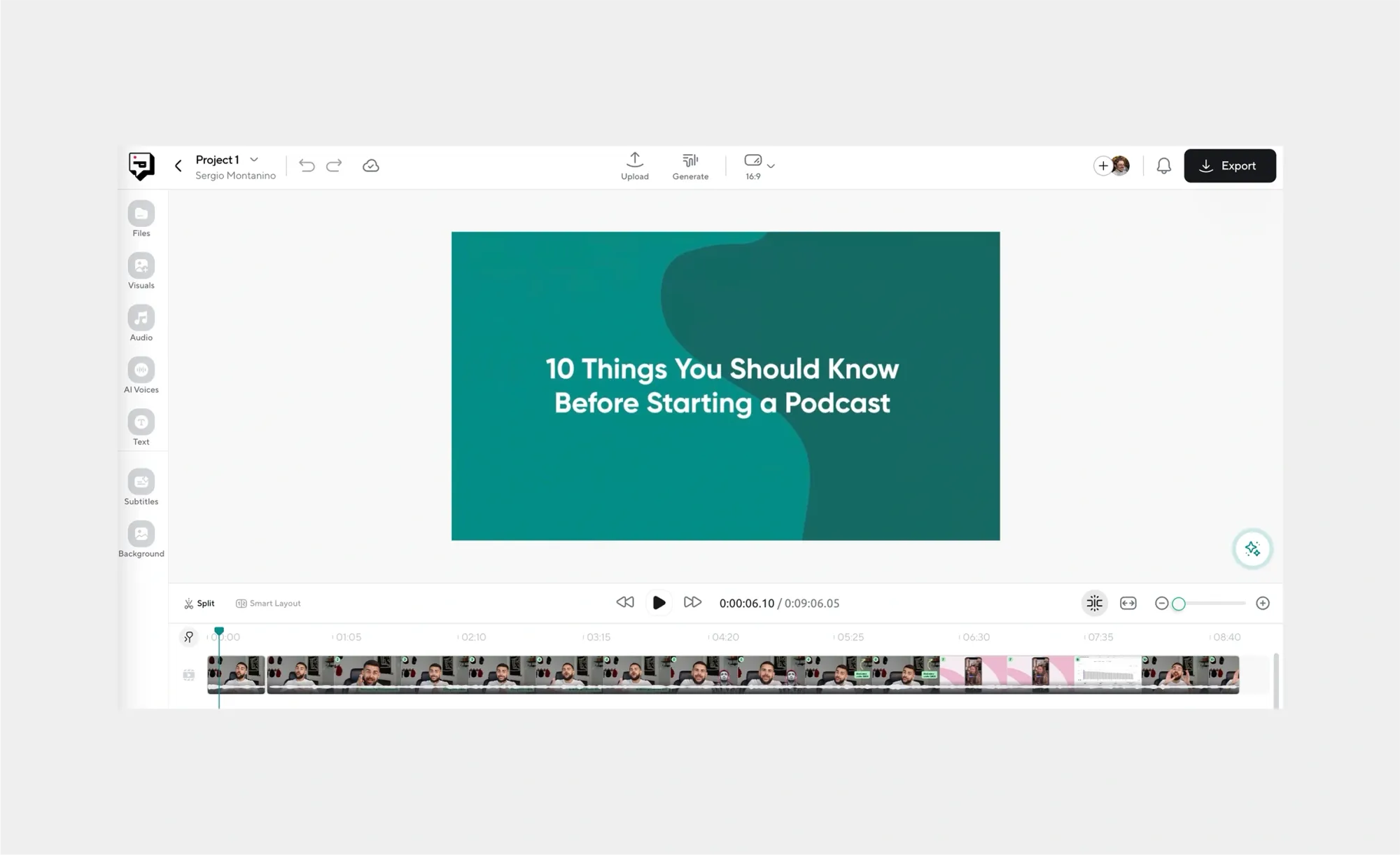
Head to the Podcastle Video Editor and upload your file. You can drag it in, browse your device, or even record something new directly in the editor.
2. Pick Your Desired Aspect Ratio
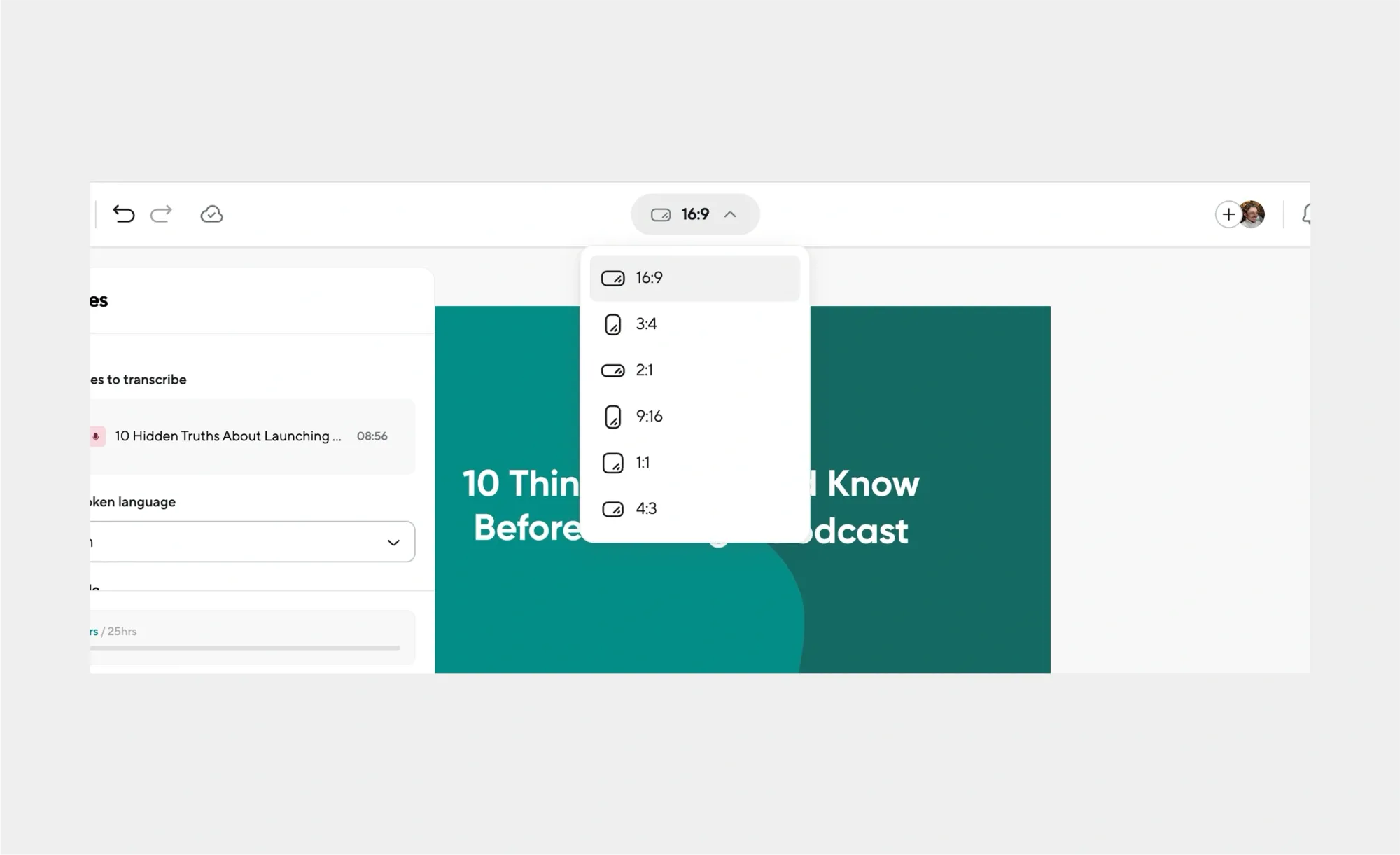
Once your video is loaded, choose the aspect ratio you need. Just select the format that fits your platform. Each option is labeled with the platform it’s designed for, so you can pick the right one with confidence.
After that, you can reposition or resize the video within the frame to keep the important parts in view.
3. Edit your Video with AI
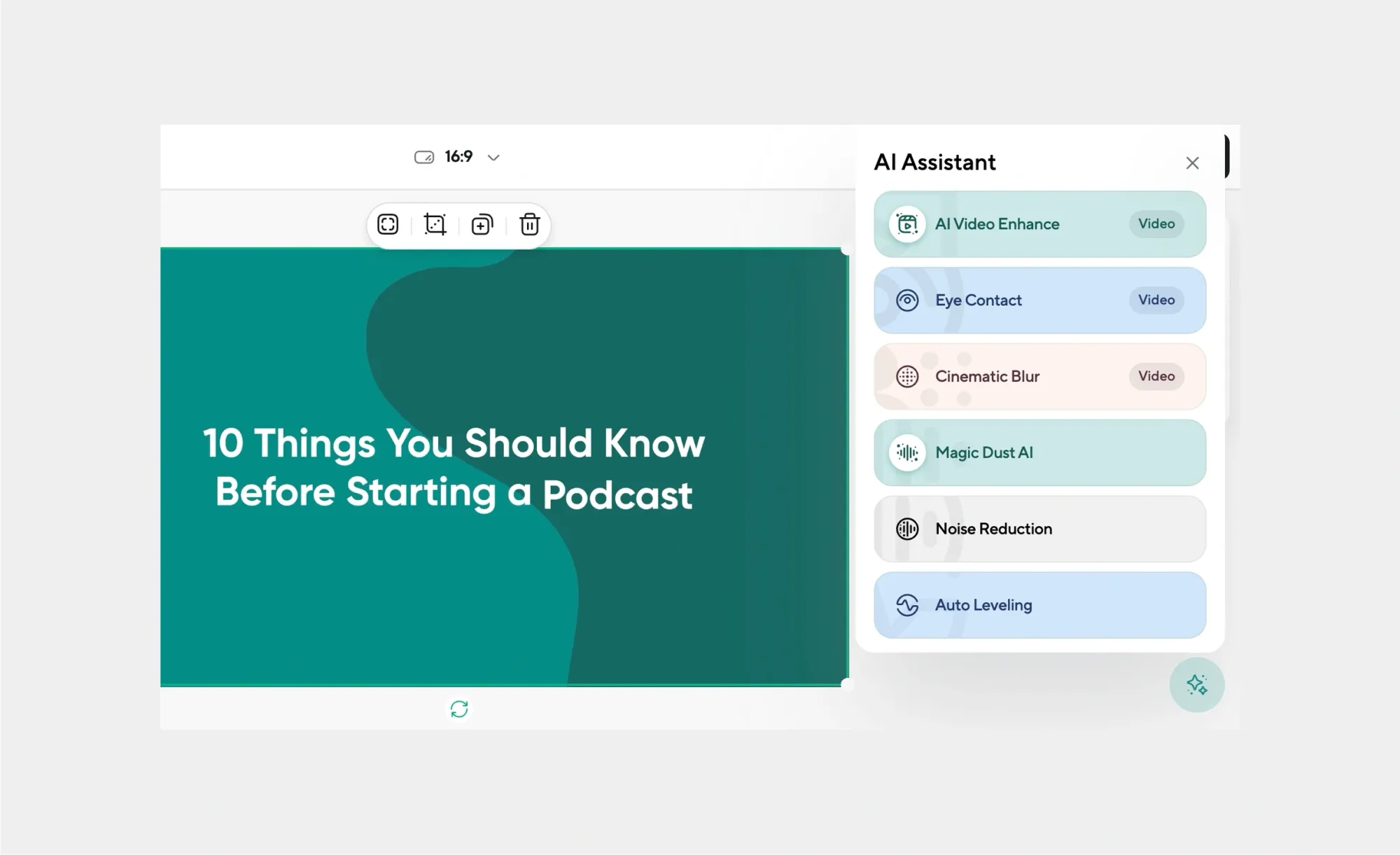
Want to polish things up a bit? Podcastle’s built-in tools let you:
- Automatic subtitling to make your content accessible to everyone.
- Transitions that can make even the simplest cuts feel cinematic.
- AI voiceovers to help you bring scripts to life.
- AI enhancement features that instantly correct eye contact, enhance video and audio quality, add cinematic blur, remove background noises and filler words.
- Splitting and trimming options that let you dissect your content with surgical precision.
4. Export and Share
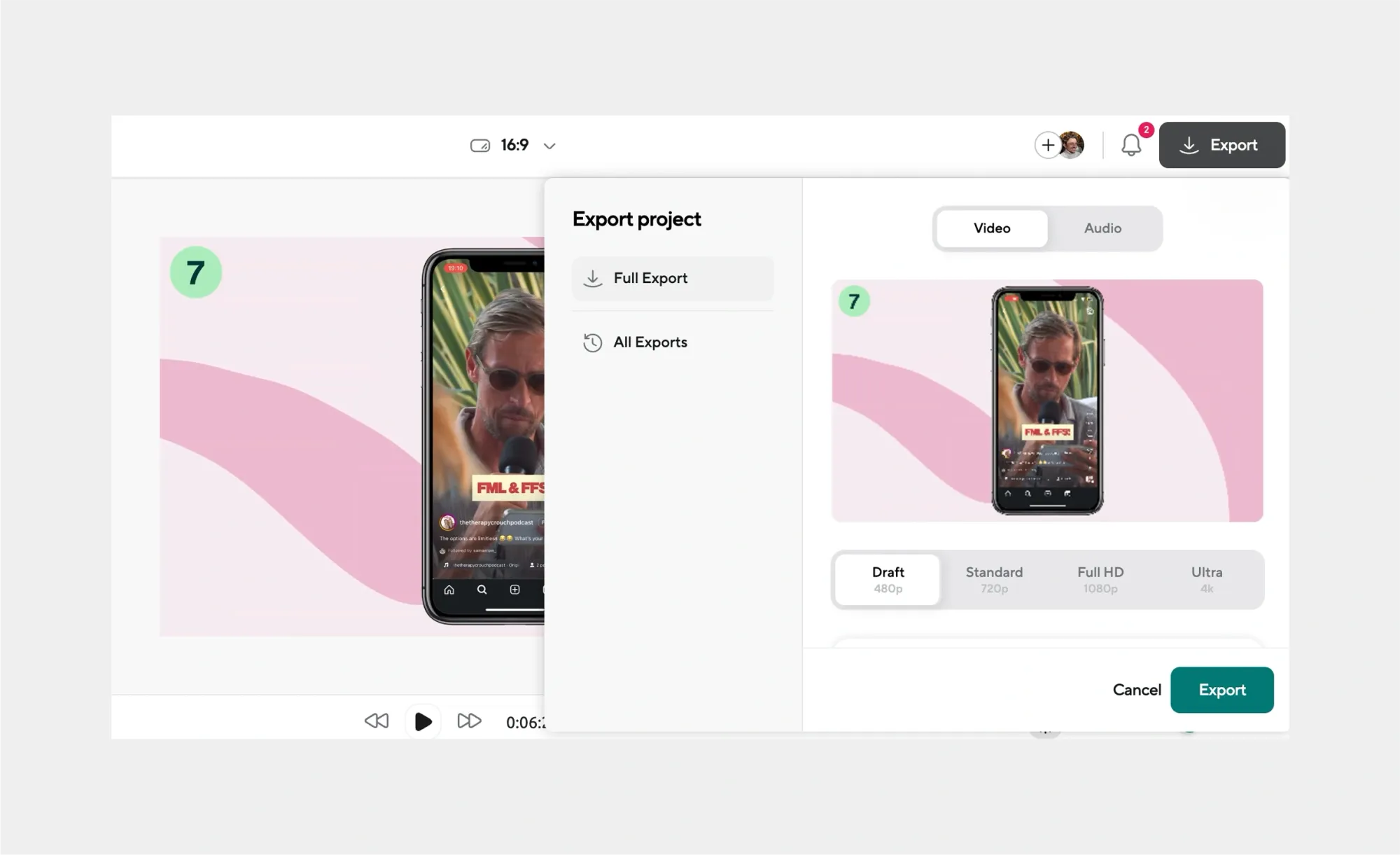
Once you’re done editing, export your video in the resolution you need. You’ll get a high-quality file ready for Instagram, TikTok, YouTube Shorts, LinkedIn, or wherever your content is headed.
How to Choose the Right Aspect Ratio: 6 Tips
Things don’t always go as planned. Sometimes you need to post the same video in a few different places. When possible, plan ahead. When you can’t, resize.
Either way, here are six quick tips to help you choose the right aspect ratio:
1. Know Your Platform
This sounds obvious, but you'd be shocked how many creators treat this like an afterthought. YouTube lives and breathes 16:9, it's optimized for it, the algorithm expects it, and your thumbnails will look better.
That said, 4:3 can still thrive on YouTube when used with purpose. If you're going for a vintage or documentary-style look, it can actually help your content stand out visually in a sea of widescreen videos.
Instagram, on the other hand, is all about vertical dominance. Reels and Stories demand 9:16. Even in the feed, portrait content (4:5) performs better than 4:3, which can end up awkwardly cropped or surrounded by black bars.
If you want to use 4:3 on Instagram, do it only if you're using it as a deliberate aesthetic choice in the main feed. For Reels and Stories, it's strongly discouraged. The same rules work for TikTok as well.
2. Consider the Mood
16:9 looks and feels cinematic. It gives you room to breathe, space for your story to unfold, and that familiar movie-watching experience that makes people lean in.
Meanwhile, 4:3 creates this intimate, almost nostalgic bubble around your content. It's cozy, it's personal, and it makes viewers feel like they're getting something special, something intentionally crafted. Your aspect ratio is literally shaping the emotional container for your message, so choose accordingly.
3. Think Mobile-First
Here's a stat that should change how you think about everything: over 57% of video content is consumed on mobile devices. That means your beautiful 16:9 masterpiece is probably being watched on a 6-inch screen held vertically.
This doesn't mean you should abandon horizontal formats, but it does mean you need to consider how your content translates to smaller screens.
Text needs to be readable, faces need to be visible, and the essential parts of your story need to work even when compressed into that mobile viewing experience.
4. Plan Your Shoot
If you know you're going to need multiple aspect ratios, and let's be honest, in 2025, you probably will, shoot wider than you think you need. Give yourself breathing room in the frame.
Podcastle's editor can work magic with cropping and repositioning, but it can't create visual information that wasn't there to begin with. Think of it as shooting for the edit, not just for the moment.
5. Test and Learn
Your audience will tell you what works, but only if you're paying attention. Try posting the same content in different aspect ratios and see what performs better. Maybe your audience loves the intimacy of 4:3, or maybe they're all about that cinematic 16:9 experience. Let their engagement guide your future decisions.
6. Don't Be Afraid to Break the Rules (Sometimes)
Once you understand the conventions, you can strategically break them for impact. A vertical video on YouTube might stand out precisely because it's unexpected. A 4:3 video on Instagram might catch the algorithm's attention because it's different. Just make sure you're breaking rules intentionally, not accidentally.
Final Thoughts
In the 4:3 vs 16:9 debate, there’s no one-size-fits-all answer. Each has its strengths. 16:9 is modern, cinematic, and widely compatible. 4:3 is vintage, artistic, and focused. The best choice depends on your platform, style, and story.
Your aspect ratio should be an extension of your vision, not an afterthought.
And that’s where having the right tools makes all the difference. Podcastle's video editor lets you take that one perfect piece of footage and give it multiple lives: the cinematic YouTube version, the intimate square Instagram post, the bold vertical Story that stops the scroll with perfectly timed cuts and maybe even an AI voiceover that matches the mood.
So go ahead: experiment, play around, break some rules. Your content deserves to look great no matter where it ends up, and with the right approach, that's exactly what will happen.
FAQ
1. What’s the main difference between 4:3 and 16:9?
4:3 is more square-shaped and is standard for older TVs and cameras, while 16:9 is a widescreen format used for modern video platforms, HD displays, and cinematic content. The main difference is in field of view and how the video fills the screen.
2. Is 4:3 still relevant for content creation today?
Yes, but mostly for stylistic or niche purposes. 4:3 is great for retro edits, vlogs, documentaries, or any content where a tighter, more intimate frame enhances the mood. It’s not obsolete, it just needs to be used intentionally.
3. Why is 16:9 considered the standard now?
Because it matches the default dimensions of most screens: TVs, smartphones (in landscape mode), monitors, and streaming platforms. It also supports HD and 4K resolutions, making it ideal for high-quality, wide-view video content.
4. Can I use both aspect ratios in one video?
You can, but transitions need to be handled carefully to avoid jarring shifts. Mixing ratios can be used for creative effect (like flashbacks or stylized segments), but consistency usually makes for a smoother viewing experience.
5. What if I chose the wrong aspect ratio while filming?
No worries. Tools like Podcastle’s video editor let you quickly resize and reframe your footage to fit the right format.
6. Which aspect ratio is best for social media content?
It depends on the platform:
- YouTube: 16:9
- Instagram Feed: 4:5 or 1:1
- Reels/Stories/TikTok: 9:16 vertical
Choosing the right ratio ensures your video fills the screen and performs better algorithmically.
7. Do I need to export different versions for each platform?
Not necessarily. With Podcastle’s resizer, you can create multiple versions from the same original video, like turning a 16:9 YouTube video into a 9:16 Instagram Reel without starting from scratch. One video shoot, many formats.
